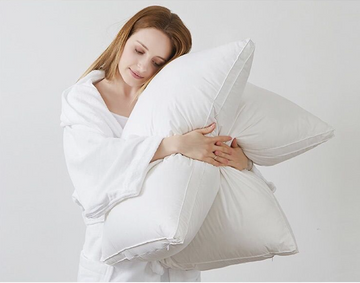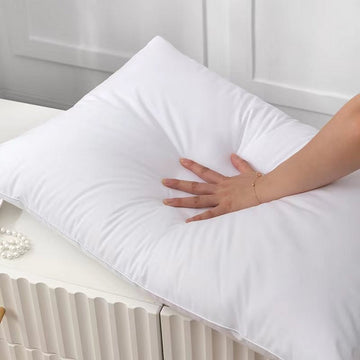Understanding the Materials: Duck Down and Goose Down in Bedding
The Origin of Duck Down and Goose Down Feathers
The origins of duck and goose down differ. Duck down comes from ducks. These are often farm-raised for meat. As a byproduct, we get their down feathers. Goose down is from geese. They are also farm-raised. But, some goose down is hand-plucked from wild birds during molting. Both types of down are used for bedding. Duck down is more common and less costly. Goose down is less common. It's seen as higher quality by some. The difference in origin affects pillow feel and durability too.
 Comparing the Quality and Durability
Comparing the Quality and Durability
When we compare duck down and goose down for pillows, quality and durability are key. Goose down tends to have larger clusters. This means it's often fluffier and lasts longer. Duck down clusters are smaller but still offer a cozy feel. Yet, they may not hold up as long as goose down. Also, high-quality duck down can rival average goose down. It depends on the fill power. Fill power shows how much space one ounce of down fills. Higher fill power means more loft and better insulation. So, goose down with high fill power is top-tier for pillows. But don't count out duck down. It provides good quality at a better price point. In short, for a long-lasting, plush pillow, goose down is the winner. For a comfy pillow that's easier on the wallet, duck down is a solid choice.
Health and Allergic Considerations
When choosing between duck down and goose down for pillows, health and allergies matter. Each type of down carries a different level of hypoallergenic properties. Goose down is generally considered less likely to trigger allergies. This is due to its larger clusters and higher purity. But, high-quality duck down is also treated to remove allergens. It's important to look for pillows with a high ‘fill power’. Fill power measures fluffiness and can also indicate a cleaning process that removes allergens. Always check if the down has been certified by a reputable body, such as the Responsible Down Standard (RDS). Encasements can also play a role. They should be tightly woven to prevent down from escaping. This can reduce exposure to potential allergens. Opt for pillows with a good barrier against dust mites and other allergens. For those with severe allergies, hypoallergenic alternatives may be the safest choice. Always remember to keep down bedding clean and dry. This helps to minimize the risk of mold and mites, both of which can trigger allergies.
The Impact of Down Type on Pillow Comfort and Performance
Analyzing the Comfort of Duck Down and Goose Down Pillows
The comfort of a pillow depends greatly on its fill. Both duck down and goose down provide a soft, fluffy feel that many find luxurious. However, goose down tends to have larger clusters. This means it's generally softer than duck down. These larger clusters also allow goose down pillows to loft higher, creating a plush sleep surface. Duck down, while still comfy, may not loft as much. It can also have a slight odor due to its diet, affecting the comfort for some users. In general, goose down is often the choice for those seeking a softer, more opulent feel in their pillow, while duck down can be a cost-effective alternative that still offers a decent level of comfort.
How Down Type Affects Sleep Quality and Satisfaction
The down in your pillow isn't just for softness; it also affects your sleep. Goose down tends to be softer and can make a pillow feel more luxurious. However, it’s usually pricier. On the other hand, duck down pillows are often more affordable but may not have the same plush feel. If you sleep on your side or stomach, the type of down can change how your neck and head are supported. For back sleepers, a higher loft in a goose down pillow could be too much. Also, the warmth provided by the down can influence comfort. Goose down typically traps more heat, so if you get hot at night, a duck down pillow might be better. Pick the type that aligns with your sleep needs and comfort preferences for the best sleep quality satisfaction.
The Role of Down in Support and Breathability
The filling in your pillow has a key job: it must keep your head and neck comfy. Down, either duck or goose, is known for its fluffiness. This fluffiness lets air flow, keeping the pillow cool. But each down type has a different feel. Duck down is dense. It gives firmer support for your head. Goose down, by contrast, is lighter and traps more air. This means it’s softer and may seem more luxurious. Still, some people find goose down too soft. They may not get the support they need. Everyone has their own idea of the perfect pillow. So, think about how you sleep and what feel you prefer. This will help you pick between duck and goose down. Remember to fluff your pillow often. This will keep the down in shape and the air moving. With good care, down pillows can be a cozy part of your bed for many years.
Selecting the Right Pillow: What Consumers Should Know
Factors to Consider When Making Your Pillow Selection
When choosing between duck down and goose down pillows, factor in your unique needs. Consider firmness; do you prefer a soft or firm pillow? Check warmth levels: goose down is warmer. Look for hypoallergenic certifications if allergies are a concern. Think about price; duck down is often less costly than goose. Consider durability: goose down pillows may last longer. Finally, try them out or read user reviews to gauge comfort.
The Best Use of Duck Down and Goose Down Pillows
When choosing between duck down and goose down pillows, think about your needs. For a firmer pillow, go for goose down. It's denser and lasts longer. If you like a softer feel, duck down is best. It's also more budget-friendly. Use goose down in cooler rooms. It retains more heat. Duck down is good for warmer rooms. It's lighter and breathes better. Pick according to the season or your heat preference. Always check for quality seals like RDS (Responsible Down Standard).
Expert Tips for Maintaining and Caring for Down Pillows
Caring for down pillows extends their life and keeps them comfy. Fluff daily to keep their loft. Wash them twice a year with gentle detergent. Dry them thoroughly to prevent mold. For longevity, use pillow protectors. Avoid getting them wet in daily use. If you have allergies, pick down pillows with hypoallergenic covers. Store them in breathable bags during off-seasons. Lastly, replace pillows every 3 to 5 years for best support and hygiene.






